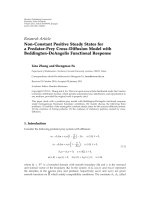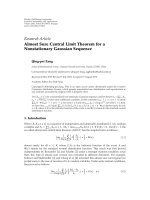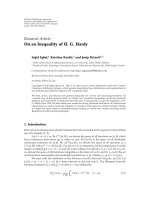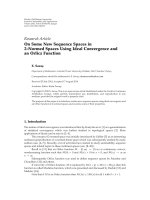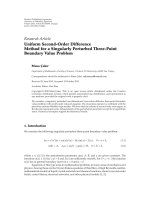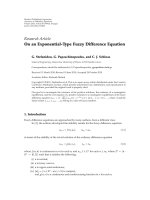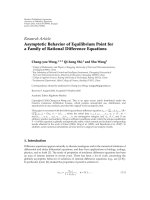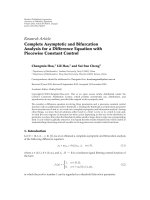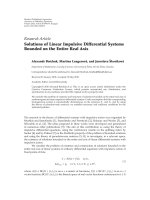Báo cáo sinh học: " Research Article On an Inverse Scattering Problem for a Discontinuous Sturm-Liouville Equation with a Spectral Parameter in the Boundary Condition" potx
Bạn đang xem bản rút gọn của tài liệu. Xem và tải ngay bản đầy đủ của tài liệu tại đây (532.55 KB, 17 trang )
Hindawi Publishing Corporation
Boundary Value Problems
Volume 2010, Article ID 171967, 17 pages
doi:10.1155/2010/171967
Research Article
On an Inverse Scattering Problem for
a Discontinuous Sturm-Liouville Equation with
a Spectral Parameter in the Boundary Condition
Khanlar R. Mamedov
Mathematics Department, Science and Letters Faculty, Mersin University, 33343 Mersin, Turkey
Correspondence should be addressed to Khanlar R. Mamedov,
Received 9 April 2010; Accepted 22 May 2010
Academic Editor: Michel C. Chipot
Copyright q 2010 Khanlar R. Mamedov. This is an open access article distributed under the
Creative Commons Attribution License, which permits unrestricted use, distribution, and
reproduction in any medium, provided the original work is properly cited.
An inverse scattering problem is considered for a discontinuous Sturm-Liouville equation on the
half-line 0, ∞ with a linear spectral parameter in the boundary condition. The scattering data of
the problem are defined and a new fundamental equation is derived, which is different from the
classical Marchenko equation. With help of this fundamental equation, in terms of the scattering
data, the potential is recovered uniquely.
1. Introduction
We consider inverse scattering problem for the equation
−ψ
q
x
ψ λ
2
ρ
x
ψ
0 <x<∞
, 1.1
with the boundary condition
−
α
1
ψ
0
− α
2
ψ
0
λ
2
β
1
ψ
0
− β
2
ψ
0
, 1.2
where λ is a spectral parameter, qx is a real-valued function satisfying the condition
∞
0
1 x
q
x
dx < ∞, 1.3
ρx is a positive piecewise-constant function with a finite number of points of discontinuity,
α
i
,β
i
i 1, 2 are real numbers, and γ α
1
β
2
− α
2
β
1
> 0.
2 Boundary Value Problems
The aim of the present paper is to investigate the direct and inverse scattering problem
on the half-line 0, ∞ for the boundary value problem 1.1–1.3. In the case ρx ≡ 1,
the inverse problem of scattering theory for 1.1 with boundary condition not containing
spectral parameter was completely solved by Marchenko 1, 2,Levitan3, 4, Aktosun 5,
as well as Aktosun and Weder 6. The discontinuous version was studied by Gasymov 7
and Darwish 8. In these papers, solution of inverse scattering problem on the half-line
0, ∞ by using the transformation operator was reduced to solution of two inverse problems
on the intervals 0,a and a, ∞. In the case ρx
/
1, the inverse scattering problem was
solved by Guse
˘
ınov and Pashaev 9 by using the new nontriangular representation of Jost
solution of 1.1. It turns out that in this case the discontinuity of the function ρ
x strongly
influences the structure of representation of the Jost solution and the fundamental equation of
the inverse problem. We note that similar cases do not arise for the system of Dirac equations
with discontinuous coefficients in 10. Uniqueness of the solution of the inverse problem and
geophysical application of this problem for 1.1 when qx ≡ 0 were given by Tihonov 11
and Alimov 12. Inverse problem for a wave equation with a piecewise-constant coefficient
was solved by Lavrent’ev 13. Direct problem of scattering theory for the boundary value
problem 1.1–1.3 in the special case was studied in 14.
When ρx ≡ 1in1.1 with the spectral parameter appearing in the boundary
conditions, the inverse problem on the half-line was considered by Pocheykina-Fedotova 15
according to spectral function, by Yurko 16–18 according to Weyl function, and according
to scattering data in 19, 20. This type of boundary condition arises from a varied assortment
of physical problems and other applied problems such as the study of heat conduction by
Cohen 21 and wave equation by Yurko 16, 17. Spectral analysis of the problem on the
half-line was studied by Fulton 22.
Also, physical application of the problem with the linear spectral parameter appearing
in the boundary conditions on the finite interval was given by Fulton 23
. We recall that
inverse spectral problems in finite interval for Sturm-Liouville operators with linear or
nonlinear dependence on the spectral parameter in t he boundary conditions were studied
by Chernozhukova and Freiling 24, Chugunova 25, Rundell and Sacks 26, Guliyev 27,
and other works cited therein.
This paper is organized as follows. In Section 2, the scattering data for the boundary
value problem 1.1–1.3 are defined. In Section 3, the fundamental equation for the inverse
problem is obtained and the continuity of the scattering function is showed. Finally, the
uniqueness of solution of the inverse problem is given in Section 4.
For simplicity we assume that in 1.1 the function ρx has a discontinuity point:
ρ
x
⎧
⎨
⎩
α
2
, 0 ≤ x<a,
1,x≥ a,
1.4
where 0 <α
/
1.
The function
f
0
x, λ
1
2
1
1
ρ
x
e
iλμ
x
1
2
1 −
1
ρ
x
e
iλμ
−
x
, 1.5
is the Jost solution of 1.1 when qx ≡ 0, where μ
±
x±x
ρxa1 ∓
ρx.
Boundary Value Problems 3
It is well known 9 that, for all λ from the closed upper half-plane, 1.1 has a unique
Jost solution fx, λ which satisfies the condition
lim
x →∞
f
x, λ
e
−iλx
1 1.6
and it can be represented in the form
f
x, λ
f
0
x, λ
∞
μ
x
K
x, t
e
iλt
dt, 1.7
where the kernel Kx, t satisfies the inequality
∞
μ
x
|
K
x, t
|
dt ≤ C
exp
∞
x
t
q
t
dt
, 0 <C const, 1.8
and possesses the following properties:
dK
x, μ
x
dx
−
1
4
ρ
x
1
1
ρ
x
q
x
, 1.9
d
dx
K
x, μ
−
x
0
− K
x, μ
−
x
− 0
1
4
ρ
x
1 −
1
ρ
x
q
x
. 1.10
In addition, if qx is differentiable, Kx, t satisfies a.e. the equation
ρ
x
∂
2
K
∂t
2
−
∂
2
K
∂x
2
q
x
K 0, 0 <x<∞,t>μ
x
. 1.11
Denote that
ϕ
λ
α
2
β
2
λ
2
f
0,λ
−
α
1
β
1
λ
2
f
0,λ
. 1.12
According to Lemma 2.2 in Section 2, the equation ϕλ0 has only a finite number of simple
roots in the half-plane Im λ>0; all these roots lie in the imaginary axis. The behavior of this
boundary value problem 1.1–1.3 is expressed as a self-adjoint eigenvalue problem.
We will call the function
S
λ
α
2
β
2
λ
2
f
0,λ
−
α
1
β
1
λ
2
f
0,λ
α
2
β
2
λ
2
f
0,λ
−
α
1
β
1
λ
2
f
0,λ
1.13
the scattering function for the boundary value problem 1.1–1.3, where
f0,λ denotes the
complex conjugate of f0,λ.
4 Boundary Value Problems
We denote by m
−2
k
the normalized numbers for the boundary problem 1.1–1.3:
m
−2
k
≡
∞
0
ρ
x
f
x, iλ
k
2
dx
1
γ
β
2
f
0,iλ
k
− β
1
f
0,iλ
k
2
, 1.14
where k 1, 2, ,n. It turns out that the potential qx in the boundary value problem 1.1–
1.3 is uniquely determined by specifying the set of values {Sλ,λ
k
,m
k
}. The set of values
is called the scattering data of the boundary value problem 1.1–1.3. The inverse scattering
problem for boundary value problem 1.1–1.3 consists in recovering the coefficient qx
from the scattering data.
The potential qx is constructed by slightly varying the method of Marchenko. Set
F
0
x
1
2π
∞
−∞
S
0
λ
− S
λ
e
−iλx
dλ
n
k1
m
2
k
e
−λ
k
x
,
F
x, y
1
2
1
1
ρ
x
F
0
y μ
x
1
2
1 −
1
ρ
x
F
0
y μ
−
x
,
1.15
where
S
0
λ
⎧
⎪
⎪
⎪
⎪
⎪
⎪
⎨
⎪
⎪
⎪
⎪
⎪
⎪
⎩
f
0
0,λ
f
0
0,λ
e
−2iλa
1 τe
−2iλaα
e
−2iλaα
τ
, if β
2
0,
f
0
0,λ
f
0
0,λ
−e
−2iλa
1 − τe
−2iλaα
e
−2iλaα
− τ
, if β
2
/
0,
1.16
and τ α − 1/α 1.
We can write out the integral equation
F
x, y
∞
μ
x
K
x, t
F
0
t y
dt K
x, y
1 −
ρ
x
1
ρ
x
K
x, 2a − y
0, 1.17
for the unknown function Kx, t. The integral equation is called the fundamental equation
of the inverse problem of scattering theory for the boundary problem 1.1–1.3.The
fundamental equation is different from the classic equation of Marchenko and we call the
equation the modified Marchenko equation. The discontinuity of the function ρx strongly
influences the structure of the fundamental equation of the boundary problem 1.1–1.3.By
Theorem 4.1 in Section 4, the integral equation has a unique solution for every x ≥ 0. Solving
this equation, we find the kernel Kx, y of the special solution 1.7, and hence according to
formula 1.10 it is constructed the potential qx.
We show that formula 1.7 is valid for 1.1. For this, let us give the algorithm of the
proof in 9. For fx, λ let us consider the integral equation
f
x, λ
f
0
x, λ
∞
x
Φ
x, t, λ
q
t
f
t, λ
dt, 1.18
Boundary Value Problems 5
where
Φ
x, t, λ
s
0
t, λ
c
0
x, λ
− s
0
x, λ
c
0
t, λ
, 1.19
while s
0
x, λ and c
0
x, λ are solutions of 1.1 when qx ≡ 0, satisfying the initial conditions
c
0
0,λs
0
0,λ1andc
0
0,λs
0
0,λ0.
It is not hard to show that the function Φx, t, λ satisfies the formula
Φ
x, t, λ
σx,t
−σx,t
K
0
x, t, z
e
iλz
dz, 1.20
where
K
0
x, t, z
⎧
⎪
⎪
⎪
⎪
⎪
⎪
⎪
⎪
⎪
⎪
⎪
⎪
⎪
⎨
⎪
⎪
⎪
⎪
⎪
⎪
⎪
⎪
⎪
⎪
⎪
⎪
⎪
⎩
1
2α
,
|
z
|
≤ σ
x, t
,x≤ t ≤ a,
1
4
1
1
α
,t− a − α
a − x
≤
|
z
|
≤ σ
x, t
,x≤ a ≤ t,
1
2
,
|
z
|
≤ t − a − α
a − x
,x≤ a ≤ t,
1
2
,
|
z
|
≤ σ
x, t
,t≥ x ≥ a,
σ
x, t
t
x
ρ
s
ds
⎧
⎪
⎪
⎪
⎨
⎪
⎪
⎪
⎩
α
t − x
,x≤ t ≤ a,
α
a − x
t − a, x ≤ a ≤ t,
t − x, a ≤ x ≤ t.
1.21
Substituting the expression 1.7 for fx, λ in the integral equation 1.18 and using formula
1.20 for Φx, t, λ after elementary operations, the following integral equations for the kernel
Kx, t are obtained:
K
x, t
1
4α
1
1
α
a
αxαa−at/2α
q
z
dz
1
4α
1 −
1
α
a
αxαaa−t/2α
q
z
dz
1
4
1
1
α
∞
a
q
z
dz −
1
4
1 −
1
α
t−αxαaa/2
a
q
z
dz
1
2α
mint,ααa−a/α
x
q
z
tαz−x
t−αz−x
K
z, s
ds dz
−
1
4
taαa−αx/2
a
q
z
t−z−a−αaαx
tz−a−αaαx
K
z, s
ds dz,
1.22
6 Boundary Value Problems
for 0 <x<a, αx − αa a<t<−αx αa a;
K
x, t
1
4
1
1
α
∞
tαx−αaa/2
q
z
dz
1
4
1 −
1
α
∞
t−αxαaa/2
q
z
dz
1
2α
a
x
q
z
tαz−x
t−az−x
K
z, s
ds dz
−
1
4
1 −
1
α
aαa−αx
a
q
z
t−zaαa−αx
tz−a−αaαx
K
z, s
ds dz
1
4
1 −
1
α
∞
aαa−αx
q
z
tz−a−αaαx
t−zaαa−αx
K
z, s
ds dz,
1.23
for 0 <x<a,t>−αx αa a;
K
x, t
1
2
∞
xt/2
q
z
dz
1
2
∞
x
q
z
dz
tz−x
t−z−x
K
z, s
ds, 1.24
for t ≥ x ≥ a.
The solvability of these integral equations is obtained through the method of
successive approximations. By using integral equations 1.22–1.24 for Kx, t, equalities
1.9, 1.10 are obtained. By substituting the expressions for the functions fx, λ and
f
x, λ in 1.1, it can be shown that 1.11 holds.
2. The Scattering Data
For real λ
/
0, the functions fx, λ and fx, λ form a fundamental system of solutions of
1.1 and their Wronskian is computed as W{fx, λ,
fx, λ} 2iλ. Here the Wronskian is
defined as W{f, g} f
g − fg
.
Let ωx, λ be the solution of 1.1 satisfying the initial condition
ω
0,λ
α
2
β
2
λ
2
,ω
0,λ
α
1
β
1
λ
2
. 2.1
The following assertion is valid.
Lemma 2.1. The identity
2iλω
x, λ
α
2
β
2
λ
2
f
0,λ
−
α
1
β
1
λ
2
f
0,λ
f
x, λ
− S
λ
f
x, λ
2.2
holds for all real λ
/
0,where
S
λ
α
2
β
2
λ
2
f
0,λ
−
α
1
β
1
λ
2
f
0,λ
α
2
β
2
λ
2
f
0,λ
−
α
1
β
1
λ
2
f
0,λ
2.3
Boundary Value Problems 7
with
S
λ
S
−λ
S
−λ
−1
. 2.4
The function Sλ is called the scattering function of the boundary value problem 1.1–
1.3.
Lemma 2.2. The function ϕλ may have only a finite number of zeros in the half-plane Im λ>0.
Moreover, all these zeros are simple and lie in the imaginary axis.
Proof. Since ϕλ
/
0 for all real λ
/
0, the point λ 0 is the possible real zero of the function
ϕλ. Using the analyticity of the function ϕλ in upper half-plane and the properties of
solution 1.7 are obtained that zeros of ϕλ form at most countable and bounded set having
0 as the only possible limit point.
Now let us show that all zeros of the function ϕλ lie on the imaginary axis. Suppose
that μ
1
and μ
2
are arbitrary zeros of the function ϕλ. We consider the following relations:
−f
x, μ
1
q
x
f
x, μ
1
μ
2
1
ρ
x
f
x, μ
1
,
−
f
x, μ
2
q
x
f
x, μ
2
μ
2
2
ρ
x
f
x, μ
2
.
2.5
Multiplying the first of these relations by
fx, μ
2
and the second by fx, μ
1
, subtracting the
second resulting relation from the first, and integrating the resulting difference from zero to
infinity, we obtain
μ
2
1
− μ
2
2
∞
0
ρ
x
f
x, μ
1
f
x, μ
2
dx − W
f
x, μ
1
,
f
x, μ
2
x0
0. 2.6
On the other hand, according to the definition of the function ϕλ, the following relation
holds:
ϕ
μ
j
α
2
β
2
μ
2
j
f
0,μ
j
−
α
1
β
1
μ
2
j
f
0,μ
j
0,j 1, 2. 2.7
Therefore,
f
x, μ
j
1
γ
β
2
f
0,μ
j
− β
1
f
0,μ
j
ω
x, μ
j
,j 1, 2. 2.8
This formula yields
W
f
x, μ
1
,
f
x, μ
2
x0
1
γ
β
2
f
0,μ
1
− β
1
f
0,μ
1
×
β
2
f
0,μ
2
− β
1
f
0,μ
2
μ
2
2
− μ
2
1
.
2.9
8 Boundary Value Problems
Thus, using 2.6 and 2.9 we have
μ
2
1
− μ
2
2
∞
0
ρ
x
f
x, μ
1
f
x, μ
2
dx
1
γ
β
2
f
0,μ
1
− β
1
f
0,μ
1
×
β
2
f
0,μ
2
− β
1
f
0,μ
2
0.
2.10
Here ρx > 0, γ>0. In particular, the choice μ
2
μ
1
at 2.10 implies that μ
2
1
− μ
1
2
0, or
μ
1
iλ
1
, where λ
1
≥ 0. Therefore, zeros of the function ϕλ can lie only on the imaginary
axis. Now, let us now prove that function ϕλ has zeros in finite numbers. This is obvious
if ϕ0
/
0, because, under this assumption, the set of zeros cannot have limit points. In the
general case, since we can give an estimate for the distance between the neighboring zeros of
the function ϕλ, it follows that the number of zeros is finite see 2, page 186.
Let
m
−2
k
≡
∞
0
ρ
x
f
x, iλ
k
2
dx
1
γ
β
2
f
0,iλ
k
− β
1
f
0,iλ
k
2
1
2iμ
k
γ
ϕ
iλ
k
β
2
f
0,iλ
k
− β
1
f
0,iλ
k
,k 1, 2, ,n.
2.11
These numbers are called the normalized numbers for the boundary problem 1.1–1.3.
The collections {Sλ, −∞ <λ<∞; λ
k
; m
k
k 1, 2, ,n} are called the scattering
data of the boundary value problem 1.1–1.3. The inverse scattering problem consists in
recovering the coefficient qx from the scattering data.
3. Fundamental Equation or Modified Marchenko Equation
From 1.9, 1.10, it is clear that in order to determine qx it is sufficient to know Kx, t.To
derive the fundamental equation for the kernel Kx, t of the solution 1.7, we use equality
2.2, which was obtained in Lemma 2.1. Substituting expression 1.7 for fx, λ into this
equality, we get
2iλω
x, λ
ϕ
λ
−
f
0
x, λ
S
0
λ
f
0
x, λ
∞
μ
x
K
x, t
e
−iλt
dt
S
0
λ
− S
λ
f
0
x, λ
∞
μ
x
K
x, t
S
0
λ
− S
λ
e
iλt
dt − S
0
λ
∞
μ
x
K
x, t
e
−iλt
dt.
3.1
Boundary Value Problems 9
Multiplying both sides of relation 3.1 by 1/2πe
iλy
and integrating over λ from −∞ to ∞,
for y>μ
x at the right-hand side we get
K
x, y
1
2π
∞
−∞
S
0
λ
− S
λ
f
0
x, λ
e
iλy
dλ
∞
μ
x
K
x, t
1
2π
∞
−∞
S
0
λ
− S
λ
e
iλty
dλ
dt
−
∞
μ
x
K
x, t
1
2π
∞
−∞
S
0
λ
e
iλty
dλ
dt.
3.2
Now we will compute the integral 1/2π
∞
−∞
S
0
λe
iλty
dλ. By elementary transforms we
obtain
S
0
λ
e
−2iλa
1 − τ
2
e
2iλaα
1 τe
2iλaα
τe
−2iλa
e
−2iλa1−α
1 − τ
2
∞
k0
−1
k
τ
k
e
2iλaαk
τe
−2iλa
,
3.3
where β
2
0. Thus we have
1
2π
∞
−∞
S
0
λ
e
iλty
dλ
1 − τ
2
∞
k0
−1
k
τ
k
δ
t y − 2a
1 − α
2aαk
τδ
t y − 2a
,
3.4
where δt is the Dirac delta function.
For β
2
/
0, similarly we get
1
2π
∞
−∞
S
0
λ
e
iλty
dλ
τ
2
− 1
∞
k0
−1
k
τ
k
δ
t y − 2a
1 − α
2aαk
τδ
t y − 2a
.
3.5
Consequently, 3.2 can be written as
K
x, y
F
S
x, y
∞
μ
x
K
x, t
F
0S
t y
dt − τK
x, 2a − y
−
1 − τ
2
∞
k0
−1
k
τ
k
K
x, 2a
1 − α
− 2aαk − y
,
3.6
10 Boundary Value Problems
where
F
0S
x
≡
1
2π
∞
−∞
S
0
λ
− S
λ
e
iλx
dλ,
F
S
x, y
≡
1
2
1
1
ρ
x
F
0S
μ
x
y
1
2
1 −
1
ρ
x
F
0S
μ
−
x
y
.
3.7
Let us show that for y>μ
x the last expression in the sum equals zero. We note that
Kx, z0forz<x. For y>μ
x we have
2a
1 − α
− 2aαk − y<μ
x
,k 0, 1, 2, 3.8
If 0 <x<a,then μ
xαx − αa a, and hence
2a
1 − α
− 2aαk − y<2a − 2aα
k 1
− αx αa − a
a − aα − 2aαk − αx < a
1 − α
≤ μ
x
.
3.9
If x ≥ a, then μ
xx, and hence, for this case, the inequality holds.
Therefore, for y>μ
x3.2 takes the form
K
x, y
F
S
x, y
∞
μ
x
K
x, t
F
0S
t y
dt
1 −
ρ
x
1
ρ
x
K
x, 2a − y
. 3.10
On the left-hand side of 3.1 with help of Jordan’s lemma and the residue theorem
and by taking Lemma 2.2 into account for y>μ
x, we obtain
−
n
k1
2iλ
k
ω
x, iλ
k
ϕ
iλ
k
e
−λ
k
y
. 3.11
From the definition of normalized numbers m
k
k 1, 2, ,n in 2.11 we have
−
n
k1
2iλ
k
ω
x, iλ
k
e
−λ
k
y
ϕ
iλ
k
−
n
k1
2iλ
k
e
−λ
k
y
f
x, iλ
k
β
2
f
0,iλ
k
− β
1
f
0,iλ
k
ϕ
iλ
k
−
n
k1
m
2
k
f
x, iλ
k
e
−λ
k
y
−
n
k1
m
2
k
f
0
x, iλ
k
e
−λ
k
xy
∞
μ
x
K
x, t
e
−λ
k
ty
dt
.
3.12
Boundary Value Problems 11
Thus, for y>μ
x, by taking 3.10 and 3.12 into account, from 3.2 we derive the relation
−
n
k1
m
2
k
f
0
x, iλ
k
e
−λ
k
xy
∞
μ
x
K
x, t
e
−λ
k
ty
dt
F
S
x, y
∞
μ
x
K
x, t
F
0S
t y
dt K
x, y
1 −
ρ
x
1
ρ
x
K
x, 2a − y
.
3.13
Consequently, we obtain for y>μ
x
F
x, y
∞
μ
x
K
x, t
F
0
t y
dt K
x, y
1 −
ρ
x
1
ρ
x
K
x, 2a − y
0, 3.14
where
F
0
x
F
0S
x
n
k1
m
2
k
e
−λ
k
x
1
2π
∞
−∞
S
0
λ
− S
λ
e
−λ
k
x
dλ
n
k1
m
2
k
e
−λ
k
x
,
F
x, y
F
S
x, y
n
k1
m
2
k
f
0
x, iλ
k
e
−λ
k
xy
1
2
1
1
ρ
x
F
0
y μ
x
1
2
1 −
1
ρ
x
F
0
y μ
−
x
.
3.15
Equation 3.14 is called the fundamental equation of the inverse problem of the scattering
theory for the boundary problem 1.1–1.3. The fundamental equation is different from the
classic equation of Marchenko and we call equation 3.14 the modified M archenko equation.
The discontinuity of the function ρx strongly influences the structure of the fundamental
equation of the boundary problem 1.1–1.3.
Thus, we have proved the following theorem.
Theorem 3.1. For each x ≥ 0, the kernel Kx, y of the special solution 1.7 satisfies the fundamental
equation 3.14.
By using the fundamental equation it is shown that the scattering function Sλ is
continuous at all real points λ and
S
0
⎧
⎨
⎩
1, if ϕ
0
/
0,
−1, if
ϕ
0
0.
3.16
It can be shown that S
0
λ−Sλ tends to zero as |λ|→∞and is the Fourier transform
of some function in L
2
−∞, ∞.
12 Boundary Value Problems
4. Solvability of the Fundamental Equation
Substituting scattering data into 3.15, we construct F
0
x and Fx, y. The fundamental
equation 3.14 can be written in the more convenient form
K
x, t μ
x
qK
x, 2a − t − μ
x
F
x, t μ
x
∞
0
K
x, ξ μ
x
F
0
ξ t 2μ
x
dξ 0,
t>0
.
4.1
We will seek the solution Kx, t μ
x of 4.1 for every x ≥ 0 in the same space L
1
0, ∞.
We consider the operators F
S
0x
, F
0x
acting in the spaces L
i
0, ∞i 1, 2, respectively,
by the rules
F
S
0x
f
∞
0
F
0S
ξ t 2μ
x
f
ξ
dξ,
F
0x
f
∞
0
F
0
ξ t 2μ
x
f
ξ
dξ
4.2
which appear in the fundamental equation.
The operators F
S
0x
, F
0x
are compact in each space L
i
0, ∞i 1, 2 for every choice of
μ
x ≥ 0. The proof of this fact completely repeats the proof of Lemma 3.3.1 which can be
found in 2.
Substituting ft ≡ Kx, t 2μ
x into 4.1,weobtain
f
t
τTf
t
F
0x
f
t
F
x, t μ
x
0, 4.3
where
Tf
t
f
2a − t
. 4.4
In order to prove the solvability of the given fundamental equation, it suffices to verify
that the homogenous equation
f
t
τTf
t
F
0x
f
t
0 4.5
has no nontrivial solutions in the corresponding space.
From the homogenous equation 4.5 we obtain
τT
f
t
τTf
t
τTF
0x
f
t
0, 4.6
and, since T
2
I, we have
τTf
t
−τ
2
f
t
− τTF
0x
f
t
. 4.7
Boundary Value Problems 13
Using this equality in 4.5, we have
f
t
τTf
t
F
0x
f
t
1 − τ
2
f
t
I − τT
F
0x
f
t
0, 4.8
or taking ftf, we obtain the equation
f −
1
1 − τ
2
I − τT
F
0x
f 0 4.9
from which 4.5 is obtained.
Theorem 4.1. Equation 4.5 has a unique solution Kx, · ∈ L
1
μ
x, ∞ for each fixed x ≥ 0.
To prove this theorem we need some of auxiliary lemmas.
Lemma 4.2. If ft ∈ L
1
0, ∞ is a solution of the homogenous equation 4.5,thenft ∈
L
∞
0, ∞.
Proof. In fact, the kernel F
0
ξ t 2μ
x of F
0x
can be approximated by a bounded function
Φξ t 2μ
x, so that
∞
0
|F
0
t − Φt|dt < 1. By rewriting 4.5 in the form
f −
1
1 − τ
2
I − τT
Φ − F
0x
f −
1
1 − τ
2
I − τT
Φf, 4.10
we obtain an equation with a bounded function on the right-hand side, where
Φf ≡ Φf
t
∞
0
f
ξ
Φ
ξ t 2μ
x
dξ. 4.11
In the space L
∞
L
∞
0, ∞ we get
Φ − F
0x
f
L
∞
≤
f
L
∞
∞
0
Φ
ξ t 2μ
x
− F
0
ξ t 2μ
x
dξ
f
L
∞
∞
t2μ
ξ
|
Φ
ξ
− F
0
ξ
|
dξ ≤
f
L
∞
.
4.12
Hence
1
1 − τ
2
I − τT
Φ − F
0x
L
∞
→L
∞
≤
1 τ
1 − τ
2
Φ − F
0x
L
∞
→L
∞
≤ 1. 4.13
Thus, the function on the right-hand side of 4.10 is bounded. Consequently, we have f
φ
∞
n1
B
n
φ, where
φ −
1
1 − τ
2
I − τT
Φf, B
1
1 − τ
2
I − τT
Φ − F
0x
, 4.14
14 Boundary Value Problems
and the series converges in L
1
0, ∞ as well as in L
∞
0, ∞; that is, the solution of the
homogenous equation 4.5 is bounded.
Corollary 4.3. If ft ∈ L
1
0, ∞ is a solution of the homogenous equation 4.5,thenft ∈
L
2
0, ∞.
Proof. In fact, ft ∈ L
1
0, ∞ ∩ L
∞
0, ∞ ⊂ L
2
0, ∞.
Thus, it suffices to investigate 4.5 in the space L
2
0, ∞.
Lemma 4.4. The operators I τT F
0x
acting in L
2
0, ∞ are nonnegative for every μ
x ≥ 0:
I τT F
0x
f, f
≥ 0, 4.15
and equality is attained if and only if
f
λ
− S
λ
e
2iλμ
x
f
−λ
0,
−∞ <λ<∞
,
f
−iλ
k
0,
k 1, 2, ,n
,
4.16
where
fλ is Fourier transform of the f unction ft.
Proof. According to definitions of the operators F
0x
and T we get
I τT F
0x
f, f
f
2
τ
∞
0
f
t
f
2a − t 2μ
x
dt
1
2π
∞
−∞
S
0
λ
− S
λ
e
2iλμ
x
f
−λ
f
λ
dλ
1
2π
∞
−∞
f
λ
2
dλ −
1
2π
∞
−∞
S
0
λ
e
2iλμ
x
f
−λ
f
λ
dλ
1
2π
∞
−∞
S
0
λ
− S
λ
e
2iλμ
x
f
−λ
f
λ
dλ
n
k1
m
2
k
f
−iλ
k
2
1
2π
∞
−∞
f
λ
− S
λ
e
2iλμ
x
f
−λ
f
λ
dλ
n
k1
m
2
k
f
−iλ
k
2
.
4.17
Since |Sλe
2iλμ
x
| 1,
∞
−∞
S
λ
e
2iλμ
x
f
−λ
fλdλ
2
≤
∞
−∞
f
−λ
2
dλ
∞
−∞
f
λ
2
dλ 4.18
by the Cauchy-Bunyakovskii inequality, or, equivalently,
∞
−∞
S
λ
e
2iλμ
x
f
−λ
f
λ
dλ
≤
∞
−∞
f
λ
2
dλ. 4.19
Boundary Value Problems 15
Therefore, the first term on the right-hand side of formula 4.17 is nonnegative. Since the
second term is obviously nonnegative. Inequality 4.16 holds, with equality, if and only if
f
−iλ
k
0
k 1, 2, ,n
,
∞
−∞
f
λ
− S
λ
e
2iλμ
x
f
−λ
fλdλ 0.
4.20
This shows that the function zλ
fλ − Sλe
2iλμ
x
f−λ is orthogonal to
fλ in
L
2
−∞, ∞. But then
fλ
2
Sλe
2iλμ
x
f−λ
2
fλ − z
λ
2
fλ
2
z
λ
2
, 4.21
which is possible if and only if zλ0. Thus, inequality 4.15 holds, with equality for
those functions ft whose Fourier transform
fλ satisfies conditions 4.16. The lemma is
proved.
With the help of Lemmas 4.2 and 4.4, we obtain the proof of Theorem 4.1. It remains
to show that the homogenous equation 4.5 has only the null solution in L
2
0, ∞. But, by
Lemma 4.4 the Fourier transform
fλ of any solution ft of 4.5 satisfies the identity
fλ−
Sλe
2iλμ
x
f−λ0. Hence, upon setting ϕ
h
λ
fλe
−iλx
√
ρx
cos λh,0<h<x
ρx,we
get
ϕ
h
λ
− S
λ
e
2iλa1−α
ϕ
h
−λ
0. 4.22
Since ϕ
h
λ is the Fourier transform of the function
ϕ
h
t
1
2
f
t h − x
ρ
x
f
t − h − x
ρ
x
, 4.23
which vanishes for t<x
ρx − h, identity 4.22 yields
ϕ
h
t
τϕ
h
2a − t
∞
0
ϕ
h
ξ
F
os
ξ t
dξ 0 4.24
for all h ∈ 0,x
ρx. Therefore, if 4.5 has nonzero solution, 4.24 has infinitely many
linear independent solutions ϕ
h
t, which in turn contradicts the compactness of the operator
F
0x
. Hence, ft0.
According to Theorems 3.1 and 4.1 the following result holds.
Theorem 4.5. The scattering data uniquely determine the boundary value problem 1.1–1.3.
Proof. To form the fundamental equation 3.14,itsuffices to know the functions F
0
x
and Fx, y. In turn, to find the functions F
0
x,Fx, y, it suffices to know only the
scattering data {Sλ−∞ <λ<∞; λ
k
,m
k
k 1, 2, ,n}. Given the scattering data,
16 Boundary Value Problems
we can use formulas 3.15 to construct the functions F
0
x,Fx, y and write out the
fundamental equation 3.14 for the unknown function Kx, y. According to Theorem 4.1,
the fundamental equation has a unique solution. Solving this equation, we find the kernel
Kx, y of the special solution 1.7, and hence, according to formulas 1.9-1.10,itis
constructed the potential qx.
Remark 4.6. In the case when ρx is a positive piecewise-constant with a finite number of
points of discontinuity, similar results can be obtained.
Acknowledgment
This research is supported by the Scientific and Technical Research Council of Turkey.
References
1 V. A. Marchenko, “On reconstruction of the potential energy from phases of the scattered waves,”
Doklady Akademii Nauk SSSR, vol. 104, pp. 695–698, 1955.
2 V. A. Marchenko, Sturm-Liouville Operators and Applications, vol. 22 of Operator Theory: Advances and
Applications,Birkh
¨
auser, Basel, Switzerland, 1986.
3 B. M. Levitan, “On the solution of the inverse problem of quantum scattering theory,” Mathematical
Notes, vol. 17, no. 4, pp. 611–624, 1975.
4 B. M. Levitan, Inverse Sturm-Liouville problems, VSP, Zeist, The Netherlands, 1987.
5 T. Aktosun, “Construction of the half-line potential from the Jost function,” Inverse Problems, vol. 20,
no. 3, pp. 859–876, 2004.
6 T. Aktosun and R. Weder, “Inverse spectral-scattering problem with two sets of discrete spectra for
the radial Schr
¨
odinger equation,” Inverse Problems, vol. 22, no. 1, pp. 89–114, 2006.
7 M. G. Gasymov, “The direct and inverse problem of spectral analysis for a class of equations with a
discontinuous coefficient,” in Non-Classical Methods in Geophysics, M. M. Lavrent’ev, Ed., pp. 37–44,
Nauka, Novosibirsk, Russia, 1977.
8 A. A. Darwish, “The inverse problem for a singular boundary value problem,” New Zeland Journal of
Mathematics, vol. 22, pp. 37–66, 1993.
9 I. M. Guse
˘
ınov and R. T. Pashaev, “On an inverse problem for a second-order differential equation,”
Uspekhi Matematicheskikh Nauk,vol.57,no.3345, pp. 147–148, 2002.
10 Kh. R. Mamedov and A. C¸
¨
ol, “On the inverse problem of the scattering theory for a class of systems
of Dirac equations with discontinuous coefficient,” European Journal of Pure and Applied Mathematics,
vol. 1, no. 3, pp. 21–32, 2008.
11 A. N. Tihonov, “On the uniqueness of the solution of the problem of electric prospecting,” Doklady
Akademii Nauk SSSR, vol. 69, pp. 797–800, 1949.
12
ˇ
S. A. Alimov, “A. N. Tihonov’s works on inverse problems for the Sturm-Liouville equation,” Uspekhi
Matematicheskikh Nauk, vol. 31, no. 6, pp. 84–88, 1976, English translation in Russian Mathematical
Surveys, vol. 31, pp. 87–92, 1976.
13 M. M. Lavrent’ev Jr., “An inverse problem for the wave equation with a piecewise-constant
coefficient,” Sibirski
˘
ı Matematicheski
˘
ı Zhurnal, vol. 33, no. 3, pp. 101–111, 219, 1992, translation in
Siberian Mathematical Journal, vol. 33, no. 3, pp. 452–461, 1992.
14 Kh. R. Mamedov and N. Palamut, “On a direct problem of scattering theory for a class of Sturm-
Liouville operator with discontinuous coefficient,” Proceedings of the Jangjeon Mathematical Society, vol.
12, no. 2, pp. 243–251, 2009.
15 E. A. Pocheykina-Fedotova, “On the inverse problem of boundary problem for second order
differential equation on the half line,” Izvestiya Vuzov, vol. 17, pp. 75–84, 1972.
16 V. A. Yurko, “On the reconstruction of the pencils of differential operators on the half-line,”
Mathematical Notes, vol. 67, no. 2, pp. 261–265, 2000.
17 V. A. Yurko, “An inverse problem for pencils of differential operators,” Sbornik: Mathematics, vol. 191,
no. 10, pp. 1561–1586, 2000.
18 V. A. Yurko, Method of Spectral Mappings in the Inverse Problem Theory, Inverse and Ill-Posed Problems
Series, VSP, Utrecht, The Netherlands, 2002.
Boundary Value Problems 17
19 Kh. R. Mamedov, “Uniqueness of the solution of the inverse problem of scattering theory for the
Sturm-Liouville operator with a spectral parameter in the boundary condition,” Mathematical Notes,
vol. 74, no. 1-2, pp. 136–140, 2003.
20 Kh. R. Mamedov, “On the inverse problem for Sturm-Liouville operator with a nonlinear spectral
parameter in the boundary condition,” Journal of the Korean Mathematical Society, vol. 46, no. 6, pp.
1243–1254, 2009.
21 D. S. Cohen, “An integral transform associated with boundary conditions containing an eigenvalue
parameter,” SIAM Journal on Applied Mathematics, vol. 14, pp. 1164–1175, 1966.
22 C. T. Fulton, “Singular eigenvalue problems with eigenvalue parameter contained in the boundary
conditions,” Proceedings of the Royal Society of Edinburgh. Section A, vol. 87, no. 1-2, pp. 1–34, 1980/81.
23 C. T. Fulton, “Two-point boundary value problems with eigenvalue parameter contained in the
boundary conditions,” Proceedings of the Royal Society of Edinburgh. Section A, vol. 77, no. 3-4, pp. 293–
308, 1977.
24 A. Chernozhukova and G. Freiling, “A uniqueness theorem for the boundary value problems with
non-linear dependence on the spectral parameter in the boundary conditions,” Inverse Problems in
Science and Engineering, vol. 17, no. 6, pp. 777–785, 2009.
25 M. V. Chugunova, “Inverse spectral problem for the Sturm-Liouville operator with eigenvalue
parameter dependent boundary conditions,” in Operator Theory, System Theory and Related Topics (Beer-
Sheva/Rehovot, 1997), vol. 123 of Operator Theory Advances and Applications, pp. 187–194, Birkh
¨
auser,
Basel, Switzerland, 2001.
26 W. Rundell and P. Sacks, “Numerical technique for the inverse resonance problem,” Journal of
Computational and Applied Mathematics, vol. 170, no. 2, pp. 337–347, 2004.
27 N. J. Guliyev, “Inverse eigenvalue problems for Sturm-Liouville equations with spectral parameter
linearly contained in one of the boundary conditions,” Inverse Problems, vol. 21, no. 4, pp. 1315–1330,
2005.
